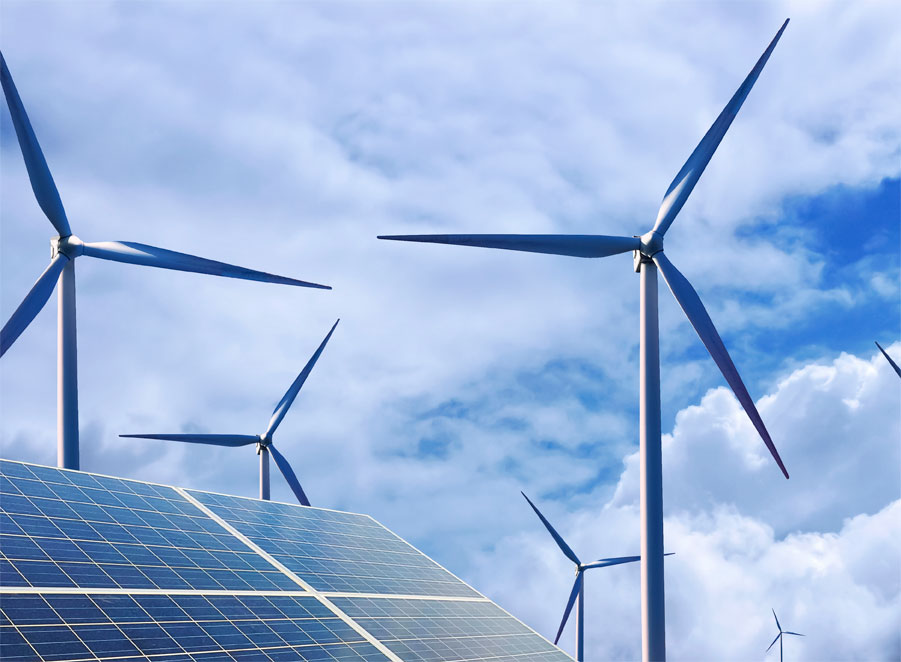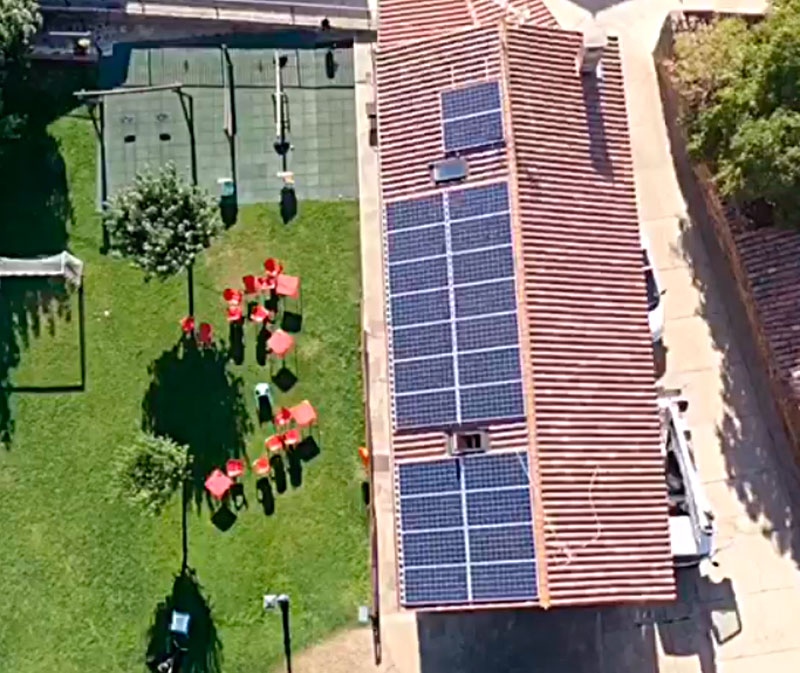Current 2021-2026 Plan
In March 2022, the cabinet approved the current Plan with a deadline of 2026 and Red Eléctrica shall be held binding.
Following the modifications approved in April 2024, in July 2025, the cabinet approved the second MAPs, aimed at reinforcing the resilience of the grid through the incorporation of additional tools to the grids that facilitate voltage control, stability in the face of oscillations and, in general, the reinforcement of the electricity system, both on the Spanish mainland and in the Canary and Balearic Islands.
All documentation, with the Modifications of specific aspects approved in 2025, is pending updating. It is currently only available in Spanish.
Projects financed by the Recovery, Transformation and Resilience Plan Funds
Below is a list of the electricity transmission network facilities included in the 2021-2026 Plan whose investment is included in the list of projects financed by the European Union – NextGenerationEU – Recovery, Transformation and Resilience Plan.
- J-0002-S0173 - SE/Magallón 400 kV (Ampl. Serna 2 y 3)
- J-0002-S0288 - SE/Serna 400 kV (Ampl.) (Magallón 2y3)
- J-0024-S0196 - SE/ Moraleja 400 kV (STATCOM)
- J-0024-S3270 - SE/ Lousame 220 kV (STATCOM)
- J-0053-L0487 - L/ Arañuelo-Valdecaba. 400 kV (A.C.)
- J-0053-L1282 - L/ San Celoní-Vic 220 kV (A.C.)
- J-00A6-L0291 - L/Sagunto-Sagunto GIS 220 kV
- J-00A6-S1450 - SE/Sagunto GIS 220 kV (Ampl.)
- J-00B0-L0808 - E/S Zuzones(Aranda) Almazán-Mudarra400kV
- J-00B0-S0278 - SE/Saucelle 220 kV (Ampl. ApD)
- J-00B0-S0808 - SE/Zuzones (Aranda) 400 kV
- J-00B0-S1036 - SE/Alcocero de Mola 220 kV (Ampl. ApD)
- J-00B2-L3826 - L/Minglanilla-Olmedilla 400 kV (A.C.)
- J-00B5-L5840 - L/La Jara- T Ayala 2 220 kV (A.C.)
- J-00C0-L2007 - L/Gatica-Güeñes 400 kV (A.C.)
- J-00C0-L2153 - L/Azpeitia-Gática 400 kV (A.C.)
- J-00C0-L2275 - L/Amorebieta-Gática 400 kV (A.C.)
- J-00C0-L2278 - L/Amorebieta-Itxaso 400 kV (A.C.)
- J-00C1-L0287 - L/Espartal-Montetorrero 220 kV (C.C.)
- J-00C1-L0824 - L/Escatrón-Espartal 220 kV (C.C.)
- J-00C5-L1042 - L/Pesoz-Sanzo 400 kV
- J-00C5-S1042 - SE/Pesoz 400 kV (Ampl.)
- J-00C6-S0090 - SE/Casillas 220 kV (Ampl. ApD) adec. PO
- J-00C9-L4644 - L/Almaraz CN-Trujillo 220 kV (C.C)
- J-00C9-L4645 - L/Mérida-Trujillo 220 kV (C.C.)
- J-00D2-S0165 - SE/Loeches 220 kV (Ampl. ApD)
- J-00D4-S1829 - SE/ Carmona 400 (Ampl VillanuevGuada)
- J-00D4-S1829-1 - SE/ Carmona 400 kV (Ampl. REA)
- J-00D5-S1092 - SE/Torrijos 220 kV (Ampl.Apd)
- J-00D8-S0012 - SE/ Ali 220 kV (Ampl.ApD)
- J-00D8-S0150 - SE/ La Jara 220 kV (Ampl. ApD 1)
- J-00E2-S0053 - SE/Boimente 400 kV (Ampl. ApD)
- J-00F0-L7448 - E/S Iznalloz L/Caparacena-Baza 400 kV
- J-00F0-S4060 - SE/ Iznalloz 400 kV (Adif POS Baza Cap.)
- J-00F7-S1838 - SE/Belinchon 400 kV (Ampl. Manchega)
- J-00F8-L8317 - E/S Abanilla(Carche)LPinilla-Rocamora400
- J-00F8-S4068 - SE/ Abanilla(El Carche) 400kV (Nueva)
- J-00F9-S0002 - SE/Abrera 220 kV (Nueva SE y Ampl.Cons)
- J-00G1-L0132 - L/Bypass Morata 400 kV
- J-00G3-S0189 - SE/Mangraners 220 kV (Ampl. PBA)
- J-00G4-S0107 - SE/El Espartal 220 kV (P.O y Cons,)
- J-00G6-S0118 - SE/Fuendetodos 400 kV (Ampl. Máq.)
- J-00G9-S0228 - SE/Picón 220 kV (Limitadores)
- J-00H3-L0828-2 - E/S La Sagra 220 L-Aceca-Añover
- J-00H3-S0828 - SE/La Sagra 400/220 kV
- J-00I4-S0130 - SE/ Sabón 220 kV (Ampl. REA)
- J-00I5-L4056 - E/S Moreruela L/GRI-VRN 400
- J-00I5-S4056 - SE/ Moreruela 400 kV (antes Piedrahita)
- J-00K1-S1241 - SE/Ciudad Deportiva 220 kV (Ampl. ApD)
- J-00K3-S0449 - SE/Boadilla 220 kV (Ampl. ApD)
- J-00K5-L0243 - L/Hernani-Argia 400 kV (C.C.)
- J-00L0-S1822 - SE/Minglanilla 400kV (ampl. ApD)
- J-00M0-L4061 - E/S Barataria(Tomelloso)-Manza-Manchg400
- J-00M0-S4061 - SE/Barataria(Tomelloso)400(Nueva+EvRE)
- J-00M5-L4199 - E/S Calatorao Jalón-Vientos a 220 kV
- J-00M5-S4199 - SE/Calatorao 220 kV (Nueva SE y Consum.)
- J-00N3-S0119 - SE/Fuentes Alcarria 400 kV (Ampl. REA)
- J-00N4-S1992 - SE/Tábara 400 kV (Ampl.REA)
- J-00P0-S0047 - SE/BENEJAMA 400 kV (Ampl ApD)
- J-00P1-L0184 - L/Meco-Nueva Meco- AVG/DGZ 220 kV
- J-00P1-S4205-1 - SE/Nueva Meco 220 kV (nueva+consum1y2)
- J-0103-S2610 - SE/Cerdá 220 kV(Ampl ApD TRP2)
- J-0105-S2090 - SE/Manzanares 400 kV (Ampl.)
- J-0202-L0025 - L/Godelleta-La Eliana 400 kV (A.C.)
- J-0202-L0199 - L/ Torrente-La Eliana 400 kV (A.C)
- J-0202-L6542 - L/Godelleta-Requena 400 kV (A.C.)
- J-0204-L0429-2 - L/ Hueneja-Tabernas 400 kV (A.C.)
- J-0204-L0586 - L/Arroyovalle-Venta Inés 220 kV (A.C.)
- J-0206-L4359 - L/Mudarrita-Palencia 220 kV (A.C.)
- J-0208-L2102-1 - L/ Telledo-Villablino 220 kV (A.C.)
- J-0210-L0317 - L/Abadiano-Vitoria 220 kV (A.C.)
- J-0211-L0106 - L/Grado-Monzón 220 kV (A.C.)
- J-0211-L0110 - L/Aragón-Ascó B 400 kV (A.C.)
- J-0211-L0125 - J-0211-L0125 L/Aragón-Escatrón 400 kV (C.C.)
- J-0214-L0012 - L/Pierola-Vandellós 400 kV (A.C.)
- J-0216-L0165 - L/Arganda-Loeches 220 kV (C. Cable)
- J-0216-L0451 - L/Arganda-Valdemoro 220 kV (C.Cable)
- J-0216-L1737 - L/ Arganda-Loeches B 220 kV (A.C.)
- J-0216-L7083 - L/Pinto-Villaverde B 220 kV (A.C.)
- J-0217-L0433 - L/Olmedilla-VillanuEscuder-Trillo40(A.C)
- J-0217-L0599 - L/Almaraz ET- Talavera 220 kV (A.C.)
- J-0217-L2243 - L/ Aceca-Los Pradillos 1 220 kV (A.C.)
- J-0218-L1725 - L/Benahadux-Órgiva 220 kV (A.C.)
- J-0229-S0341 - SE/ Viladecans 220 kV (Ampl. REA)
- J-0230-L6614 - E/S Masdenverge VAN-PLA
- J-0230-S3335 - SE/Masdenverge 400kV
- J-0254-L8085 - E/S Ronda L_Jordana-Tajo 400 kV
- J-0254-S2131 - SE/ Ronda 400 kV
- J-0258-S0912 - SE/Valdemoro 220 kV (APD)
- J-0279-S3973 - SE/ Luminabaso 220 kV
- J-0311-L6017 - L/ Mangraners-Espluga-Begues 220 kV
- J-0315-L2146 - E/S San Fernando L/Algete-Ardoz 220 kV
- J-0315-L2147 - L/San Fernando-P.S. Fernando 220 kV
- J-0334-L7511 - E/S Fontefría L/Suido-Pazos 220 kV
- J-0334-L7512 - E/S Beariz L/ Mesón-Cartelle 400 kV
- J-0334-L7514 - L/Fontefría-Frontera Portugal 400 kV
- J-0334-L7515 - L/ Beariz-Fontefría 400 kV
- J-0334-S4509 - SE/ Beariz 400 kV
- J-0334-S4510 - SE/ Fontefría 400-220 kV
- J-0336-L6063 - E/S Don Alvaro-L_Almaraz-Bvenid 400kV
- J-0336-S2041 - SE/ Don Alvaro 400 kV
- J-0342-L2215 - E/S ANTAS(Ribina)L/Carril-Litoral1 400
- J-0342-S0801 - SE/Baza 400 kV (Ampl. ApD)
- J-0342-S2199-1 - SE/ANTAS(Ribina)400 kV(Ampl.EvRE)
- J-0348-L6152 - E/S Torrejón Velasco LMor-Vil
- J-0348-S2071-1 - SE/Torrejón de Velasco 400 kV
- J-0380-S0018 - SE/ Anchuelo 400 kV (Ampl.REA)
- J-0380-S0170 - SE/Anchuelo 400 kV (Pos ampl+Trafo)
- J-0382-L0549 - L/Algeciras-V. Africa 132 kV (C.Sub)
- J-0382-S0162 - SE/Algeciras 132 kV
- J-0382-S0339 - SE/Virgen de Africa 132 kV
- J-0382-S9161 - SE/Algeciras 220kV
- J-0390-S0597 - SE/Mataporquera 220 kV (Ampl.)
- J-0414-L8693 - E/S Almendrales L/Aragon-Mequin 400 kV
- J-0414-S8663 - SE/Almendrales 400 kV (Nueva SE y EvRe)
- J-0434-S0188 - SE/Abanto 400 kV (Ampl. ApD)
- J-0443-S3073 - SE/Haro 220 kV (Ampl. ApD)
- J-0445-S1014 - SE/El Palmeral 220 kV (Ampl. ApD)
- J-0458-L6943 - E/S Fuentebureba(Briviesca)Grjta-Vitoria
- J-0458-S3254 - SE/Fuentebureba (Briviesca) 400 kV
- J-0470-L6993 - E/S Zarzón(Pinofranqueado)L/Ald-Arañl400
- J-0470-S2042 - SE/ Zarzón 400kV (antes Pinofranqueado)
- J-0475-S0025 - SE/Arañuelo 400 kV(PoliTrafo)
- J-0476-S1186 - SE/La Selva 220 kV (Ampl. Francoli)
- J-0476-S1538 - SE/Els Aubals 220 kV (Ampl.)
- J-0476-S2531 - SE/Escatrón 400 kV (Ampl.)
- J-0532-S0017 - SE/ Almazán 400/220 kV (Ampl.)
- J-0532-S0017-1 - SE/Coscurita 220 kV
- J-0532-S3294 - SE/Magaña 220 kV (Ampl.)
- J-0536-L2965 - E/S Ventilla (Mijas Norte) 220 kV
- J-0541-S0097 - SE/Don Rodrigo 220 kV (Ampl. ACP 1y2)
- J-0548-L3345 - E/S Elda L/Benejama-Petrel 220 kV
- J-0566-S0624 - SE/Trujillo 220 kV (Ampl. ApD)
- J-0574-L0663 - L/Alcobendas-Fuente Hito 220 kV
- J-0574-S2640 - SE/ Fuente Hito 220 kV
- J-0593-L2725 - E/S VillatoroL/Güeñes-Villalbilla 220 kV
- J-0593-S2725 - SE/ Villatoro 220 kV
- J-0607-S0407 - SE/Castellón (AT1)
- J-0621-S1969 - SE/ Tabernas 220 KV (STATCOM)
- J-0654-S2419 - SE/San Fernando 220 kV (Ampl. APD)
- J-0690-L3178 - L/ Tierra Estella-Muruarte 220 kV
- J-0690-S3178 - SE/ Tierra Estella 220 kV
- J-0719-L0033 - E/S Almadén LAlmz CN-Guad
- J-0719-S4763 - SE/ Almadén 400 kV
- J-0720-L3997 - E/S Quintana Serena/Valdeca-Carmona400
- J-0720-S1978 - SE/ La Serena 400 kV
- J-0740-S2153 - SE/ Solórzano 400 kV (Ampl. REA)
- J-0769-S0213-1 - SE/ Olmedilla 220 kV (Adec. PO)
- J-0771-L4044 - E/S Fte Cantos L/Brovales-Gui 400 kV
- J-0771-S4044 - SE/ Fuente de Cantos 400 kV
- J-0772-L0085 - E/S Maguilla(Llerena)/Valdec-Guillena400
- J-0772-S4059 - SE/ Maguilla 400 kV (POS Valde GUI EvRE)
- J-0784-S1827 - SE/Santa Ponsa 220 kV (Compensador 1)
- J-0786-S1428 - SE/ Mercadal 132 kV (Baterías)
- J-0786-S1439 - SE/ San Antonio 66 kV (Baterías)
- J-0789-S1357 - SE/Requena 400 kV (Ampl.)
- J-0790-L4045-1 - E/S Fte Maestre L/San Servan-Brovales
- J-0790-S4045 - SE/ Fuente Maestre 400 kV
- J-0799-L0272 - L/Sta Engracia-Barcina 400 kV (A.C.)
- J-0806-S1827 - SE/Santa Ponsa 220-132 kV (Trafo)
- J-0806-S1827-1 - SE/ Santa Ponsa 132 kV (Ampl. REAs)
- J-0822-S2976 - SE/Bessons 132 kV (Ampl.)
- J-0897-S1414 - SE/ Bunyola 66 kV (Ampl. PO)
- J-0897-S2980 - SE/ Cala Millor 66 kV (Ampl. PO)
- J-0901-L6609 - L/Geneto-El Rosario 66 kV
- J-0905-L7013 - L/Sabinal Telde y Marzagan 66kV
- J-0905-S2375 - SE/Sabinal (Teld y Marzagan) 66
- J-0906-L6355 - L/Pto. del Rosario-Gran Tarajal 132 kV
- J-0907-S3468 - SE/ Tías 66 kV (Ampl. REA)
- J-0910-S3092-2 - SE/Matas Blancas 66 kV (Adec. PO)
- J-0912-L6374 - L/Chío-Los Olivos 66 kV
- J-0926-S8661 - SE/Drago 66 kV
- J-0927-S3353 - SE/Abona 220 kV (Ampl.)
- J-0936-L0125 - L/El Rosario-Manuel Cruz-Diq. Este 66kV
- J-0936-L7325 - L/El Rosario-Guajara 66 kV
- J-0947-L6307 - L/Buenos Aires-Caletillas 220 kV
- J-0947-S3002 - SE/Buenos Aires 220 kV
- J-0951-L7585 - L/Sta. Agueda-Bco. de Tirajana 220 kV
- J-0951-S1332 - SE/Arguineguin 66 kV (Ampl.)
- J-0958-L0547 - L/ Chío-La Gomera 66 kV (c. sub.)
- J-0958-S3918 - SE/ Chío (Nueva Guía de Isora) 66 kV
- J-0958-S4280 - SE/ El Palmar de la Gomera 66 kV
- J-0970-S2013 - SE/Vallitos 220 kV (Ampl. Trafo)
- J-0975-S1308 - SE_Gran Tarajal 66 kV (Amp + PO)
- J-0975-S1312 - SE/ Corralejo 66 kV (Adec. PO)
- J-0975-S1316 - SE/ Telde 66 kV (Ampl. PO)
- J-0975-S1339 - SE/ San Agustin GC 66 kV (Adec. PO)
- J-0975-S1348 - SE/ Macher 66 kV (Adec. PO)
- J-0975-S3919 - SE/ Guinchos 66 kV (Ampl. PO)
- J-0977-S1329 - SE/ Arucas 66 kV (Compensadores)
- J-0977-S3470 - SE/ Jares 132 kV (Compensadores)
- J-0OIO-S1882 - SE/ Maials 400 kV (Ampl. REA)
- J-0R01-L0564 - L/Villalbilla-Villimar 220 kV (Renov.)
- J-0R01-L2358 - L/Alcocero-Villimar 220 kV (Renov.)
- J-0R01-S0048 - SE/Meson do Vento 220 kV (Renov.)
- J-0R01-S0131 - SE/Grijota 400 kV (Renov.)
- J-0R02-L0242 - L/ Arkale-Argia 220 kV (Renov.)
- J-0R02-S3649 - SE/Gatica 400 kV (Renov.)
- J-0R03-L0535 - L/Rubi-Viladecans 220 kV (Renov.)
- J-0R04-S0327 - SE/Trillo 400 kV (Renov.)
- J-0R05-S0128 - SE/Guadame 400 kV (Renov.)
- J-0R05-S0320 - SE/Tajo Encantada 400 kV (Renov.)
- J-0R06-L3659 - L/ Albal-Torrente 220 kV (Renov.)
- J-0Y01-S0144 - SE/ Herrera 400 kV (Renov. Rea)
- J-0Y01-S0597 - SE/ Mataporquera 220 kV (Renov.)
- J-0Y02-S3649 - SE/Gatica 400 kV (Renov. Maq.)
- J-0Y03-S0068 - SE/ Can Jardi 400 kV (Renov. Maq.)
- J-0Y04-S0196 - SE/Moraleja 400 kV (Renov. Maq.)
- J-0Y06-S0043 - SE/Litoral 400 kV (Renov.)
- J-0Y07-S1365 - SE/ Chayofa 66 kV (Renov.)
- J-0Y08-L0322 - L/Aena -Hortaleza 220kV(Tr Corralón H)
- J-0Z07-S0359 - SE/Villanueva del Rey 220 kV AT-1
- J-0Z29-S0234 - SE/Peñaflor 400_220 (trafo)
- J-0Z33-S0985 - SE/ Olmedo 400 kV (Ampl. REA) (DDA)
- J-0Z33-S1961 - SE/Silleda 400 kV (Ampl.REA)
- J-0Z33-S3502 - SE/ Beariz 400 kV (Ampl. REA)(DDA)
- J-0Z38-S4047 - SE/Calera y Chozas 220 kV (Ampl)(AnexoI)
- J-0Z47-L1183-1 - L/ Gaussa-Saguntum 400 kV (DDA)
- J-0Z47-L7451-2 - E/S Saguntum L-MRV-ElI- Sagunto 220KV
- J-0Z47-L7451-4 - L/ Saguntum-Palancia 220 kV (DDA)
- J-0Z47-S7451 - SE/ Saguntum 400-220 kV (DDA)
- J-90A7-L0203 - E/S Francolí 220kV
- J-90C6-L1035 - E/S Guadaira L/ Aljarafe-Don Rod 220 kV
- J-90D6-S1971 - SE/Esquedas 220 kV (Ampl. APD)
- J-90E4-L0098 - E/S Calera y Chozas 220 kV
- J-90J1-L3878 - E/S El Condado L/Colon-Santiponce
- J-9130-L0063 - L/Cartuja-Puerto Real 220 kV
- J-9253-L0866 - L/El Zumajo-Puerto Real 220 kV
- J-9279-L0285 - E/S Luminabaso L/Sidenor-Abadiano 220 kV
- J-9566-L6770 - L/Caceres-Los Arenales 220 kV
- J-9566-L6875 - L/Trujillo 1-Los Arenales 220 kV
- J-9824-L3722 - L/Ibiza-Bossa 132 kV
- J-9825-L4456 - L/Bossa-San Jorge 132 kV
- J-9825-S1441 - SE/San Jorge 132 kV
- J-9911-L2857 - E/S San Isidro L/Granadilla-Arona
- J-9923-L4258 - E/S Los Vallitos L/Chayofa-Olivos 66 kV
- J-9939-L4583-1 - L/Bco.Tirajana 2-Bco.Tirajana 3 220 kV
- J-9939-S4583 - SE/ Bco. de Tirajana 3 220 kV
- J-9GD0-S0203 - SE_Francolí 220kV (antes Morell)
- J-9GD0-S2857 - SE/ San Isidro 66 kV
- J-9GD0-S2908 - SE/ Guadaira 220 kV
- J-9GD0-S2965 - SE/Ventilla 200 KV - Antes Mijas N y Ent
- J-9GD0-S3519 - SE/ Saleres 220 kV
- J-9GD0-S3878 - SE/ El Condado 220 kV
- J-9GD0-S4047 - SE/Calera y Chozas 220 kV

More renewable
We will strengthen the grid to connect and integrate a new contingent of renewable generation at the pace set by the PNIEC and make it available to consumers.
Thanks to the developments contemplated in the 21-26 Planning, 37,000 MW of new renewable facilities will be connected so that in 2026 these green energies will reach a share of 67% in the national electricity production mix. Thus, CO2 eq emissions will be reduced by 66% with respect to those recorded in 2019 (the year prior to the pandemic), provided that the PNIEC forecasts and the full implementation of this Planning are met.
Did you know that if we do not implement this planning, we will waste 15% of green production? On the contrary, with the planned developments, this waste will be reduced to 4%, in line with European recommendations. Thanks to this progress in the green transition process, in 2026 the CO2 eq emissions of our electricity system will stand at 17 million tons of CO2 eq, which will represent a 66% reduction compared to those recorded in 2019.

More connected
The Planning will allow us to continue enjoying a safe, continuous and high quality electricity supply and will allow us to meet new demands and needs.
Planning 21-26 dedicates 27% of its total investments to the development of actions that will reinforce the reliability of the electricity supply where it is necessary and will strengthen both the link between the transmission grid and the distribution networks and the supply of large industrial demands or railway axes. Specifically, the Plan will enable the supply of 13 new railway lines and will facilitate the supply of new large consumers.
Likewise, projects such as the inter-island links and the reinforcement of the interconnection between the Peninsula and the Balearic Islands are contemplated, which will contribute decisively to the security of supply in these territories and cover their demand.
Finally, this Planning also includes the development of vital international interconnections to continue strengthening the quality and security of our supply, because the larger a system is, the more secure it is. These links with other countries will also contribute to consolidating Spain's integration into Europe's Internal Electricity Market.

More wellness
The planned investments will boost economic activity and strengthen the industrial fabric of the regions, creating jobs, wealth and well-being.
Planning will be a catalyst for economic and social progress in our country, providing a strong impetus to the necessary post-pandemic recovery process. The planned investments will activate the sectors associated with the installation of electricity infrastructures. In this way, the creation of these new infrastructures will create employment, wealth and new opportunities in the territory.
On the other hand, all the Plan's actions are aimed at achieving maximum efficiency and economic sustainability and have been designed with the minimum cost to the consumer in mind. In this way, this development plan as a whole will generate significant savings and efficiencies for the electricity system that will benefit consumers.
Networks that protect our environment

The planning process followed a rigorous Strategic Environmental Assessment procedure to make it sustainable and respectful of the environment. In this way, environmental and territorial conditioning factors have been prioritized in its design, with a greater use of the existing network, avoiding the most sensitive areas and reducing actions with an environmental effect on the territory. In fact, only 13% of all the renewable generation expected to be connected by 2026 in areas where this is not currently possible will require new transmission substations.
The planning process followed a rigorous Strategic Environmental Assessment procedure to make it sustainable and respectful of the environment. In this way, environmental and territorial conditioning factors have been prioritized in its design, with a greater use of the existing network, avoiding the most sensitive areas and reducing actions with an environmental effect on the territory. In fact, only 13% of all the renewable generation expected to be connected by 2026 in areas where this is not currently possible will require new transmission substations.

Networks that we have designed together and for everyone

This electrical planning is the result of an exercise of collective responsibility. Public administrations and the different agents of civil society have participated in its preparation, working together with a common goal: to build, together, a useful and valuable network for all. For the first time, the consultation process has been open to all citizens, companies and administrations, whose high participation (more than 3,200 allegations) has demonstrated the enormous interest of society as a whole in the process of ecological transition.
This electrical planning is the result of an exercise of collective responsibility. Public administrations and the different agents of civil society have participated in its preparation, working together with a common goal: to build, together, a useful and valuable network for all. For the first time, the consultation process has been open to all citizens, companies and administrations, whose high participation (more than 3,200 allegations) has demonstrated the enormous interest of society as a whole in the process of ecological transition.

